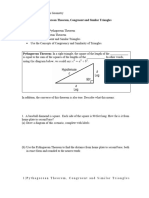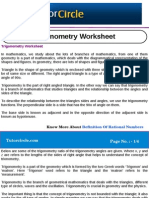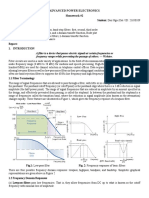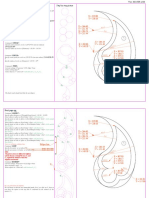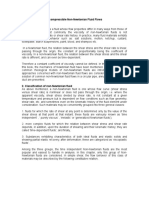Triangle Inequality Theorem
Triangle Inequality Theorem
Uploaded by
api-174648067Copyright:
Available Formats
Triangle Inequality Theorem
Triangle Inequality Theorem
Uploaded by
api-174648067Original Title
Copyright
Available Formats
Share this document
Did you find this document useful?
Is this content inappropriate?
Copyright:
Available Formats
Triangle Inequality Theorem
Triangle Inequality Theorem
Uploaded by
api-174648067Copyright:
Available Formats
Triangle Inequality Theorem
Triangle Inequality Theorem In mathematics, here we will study about the Triangle Inequality Theorem. Before solving the theorem first it is necessary to know about the triangle. Triangle is a three line paked shape that is linked end- to- end with each other. In a triangles vertex, base, altitude, median, area, perimeter, interior angles, and exterior angles are present. In mathematical geometry generally we will study seven types of triangle which are given as: Isosceles Triangle Equilateral Triangle Scalene Triangle Right Triangle Obtuse triangle Acute and equiangular Triangle. Know More About :- How to Find the Volume of a Rectangular Prism Math.Tutorvista.com
Page No. :- 1/4
A triangle have three sides, out of three sides any one side of a triangle is always smaller than the total sum of all the two other sides is the inequalities of triangle. In the opposite case, if any one side of a triangle is always larger than the total sum of all the two sides than the triangle cannot be found. In the above mention figure, we will understand that the length of two sides P and Q when added then it is less than the length of R because it violets the definition of triangle inequalities, inequalities of triangles theorem. As we know that the triangle is having the same sides, and the angle that is opposite to these sides are also same. In case of a triangle if two sides are not equal than the sum of angles opposite to these sides are also not equal. And the angle which is larger is just opposite the larger side. Other theorem that if two angles in a triangle is not equal then the sum of all the sides opposite these angles are also not equal. As we see that in a triangle three sides are present and one side of a triangle is smaller than the sum of two other sides, if one side of a triangle is larger than the sum of two other sides than the triangle cannot be found, it is the opposite case. In the above given figure (1), we see that the length of two sides P and Q when added then it is less than the length of R because it violates the definition of triangle inequalities. A triangle is having equal sides, and the angle that is different to these sides is also same. If two sides of a triangle are not equal than the sum of angles different to these sides are also not same. The larger angle is just opposite to the larger side. If two angles in a triangle are not equal then the sum of all the sides opposite to the angles is not equal. Then the larger side of a triangle is just opposite to the larger angles of a triangle. Learn More :- System of Linear Equations Math.Tutorvista.com
Page No. :- 2/4
And now in figure (2), p + q > r; q + r > p; r + p > q; If the given triangle follows all three conditions then we can say it satisfies the triangle inequality theorem. Now we will see some formula based on triangle. If we want to find the area of triangle then we will use the formula. The formala to find the area of triangle is given as: Area of triangle = 1 / 2 * b, h; here b shows the breadth and h shows the slant height of a triangle
Math.Tutorvista.com
Page No. :- 4/4
ThankYouForWatching
Presentation
You might also like
- Reciprocal Functions Also ImportantDocument4 pagesReciprocal Functions Also ImportantDivineJusticeNo ratings yet
- PostulatesDocument49 pagesPostulatesRalph Kirby Cañete FelicitaNo ratings yet
- Congruent and Similar Triangles Accessible 7BzrFkhDocument6 pagesCongruent and Similar Triangles Accessible 7BzrFkhbskhadaa08No ratings yet
- Encyclipedia of Trignometry - Andrew BarnesDocument140 pagesEncyclipedia of Trignometry - Andrew Barnessaka1977No ratings yet
- Homework 5.6 Part CDocument8 pagesHomework 5.6 Part CLin Xian XingNo ratings yet
- How To Find Area of A TriangleDocument4 pagesHow To Find Area of A Triangleapi-162641823No ratings yet
- Elective Reviewer 3rd Quarter Grade 9Document5 pagesElective Reviewer 3rd Quarter Grade 9alagonm23No ratings yet
- Trigonometry WorksheetDocument4 pagesTrigonometry Worksheetapi-143521979No ratings yet
- Govt. Ser. Sec. Model School P.A.U, Ludhiana: Presented ByDocument14 pagesGovt. Ser. Sec. Model School P.A.U, Ludhiana: Presented ByKUSUMPAUSCHOOLNo ratings yet
- Triangle Trigonometry TestDocument5 pagesTriangle Trigonometry TestPortia LanierNo ratings yet
- Ekhuni Print LagbeDocument4 pagesEkhuni Print LagbemrnobodycaresaboutNo ratings yet
- Concepts MMWDocument7 pagesConcepts MMWJoshua CuarterosNo ratings yet
- Theorem 7Document11 pagesTheorem 7terezkiNo ratings yet
- 12.4 Converse On TrianglesDocument12 pages12.4 Converse On TrianglesTonet Salago CantereNo ratings yet
- Angad's PresentationDocument11 pagesAngad's PresentationjanviangadraoNo ratings yet
- Geometry PortfolioDocument8 pagesGeometry Portfoliowhis2022No ratings yet
- Math8 Q4 ReviewerDocument4 pagesMath8 Q4 ReviewerMicmic Mary ChloeNo ratings yet
- Proj in MathDocument10 pagesProj in MathRence Jay DimacuranNo ratings yet
- Summary of Trigonometric FormulasDocument1 pageSummary of Trigonometric Formulasmhammed Charradi ffNo ratings yet
- TheoremsDocument8 pagesTheoremsanjustic25No ratings yet
- Squares and Triangles: Z What Is The Area of This Square?Document8 pagesSquares and Triangles: Z What Is The Area of This Square?Brian BrooksNo ratings yet
- Trigonometry BasicsDocument9 pagesTrigonometry Basicsprabhusanjana15No ratings yet
- Geometry Summer ReviewDocument12 pagesGeometry Summer ReviewAric DelinaNo ratings yet
- By Relative Lengths of Sides: Regular PolygonDocument13 pagesBy Relative Lengths of Sides: Regular Polygonjunior_bassgNo ratings yet
- Triangle: (Classifying Triangles)Document15 pagesTriangle: (Classifying Triangles)Nezir M AliNo ratings yet
- FormulasDocument28 pagesFormulasA CNo ratings yet
- The Area of A TriangleDocument4 pagesThe Area of A Triangleapi-150547803No ratings yet
- Area of The TriangleDocument4 pagesArea of The Triangleapi-150547803No ratings yet
- Math9 Q3 WK7Document25 pagesMath9 Q3 WK7DENISE MAREE ROMASANTANo ratings yet
- Ussd CodeDocument37 pagesUssd CodeksmNo ratings yet
- Geometry Project 2Document27 pagesGeometry Project 2Eddie MurphyNo ratings yet
- Fundamental Concepts of Triangles: Sides of A TriangleDocument13 pagesFundamental Concepts of Triangles: Sides of A TriangleRajni KashyapNo ratings yet
- 6 Triangles 2Document16 pages6 Triangles 2Rajveer KaushalNo ratings yet
- Positive Number: Absolute ValueDocument23 pagesPositive Number: Absolute ValueSarah Joy ManimtimNo ratings yet
- Properties of Similar TrianglesDocument4 pagesProperties of Similar TrianglesSu Sieng LeeNo ratings yet
- Triangles and QuadrilateralsDocument24 pagesTriangles and QuadrilateralsStephanie Kyle PentinioNo ratings yet
- Triangles in Geometry (Definition, Shape, Types, Properties & Examples)Document13 pagesTriangles in Geometry (Definition, Shape, Types, Properties & Examples)Thanuja RaniNo ratings yet
- Inequalities in TrianglesDocument1 pageInequalities in TrianglespavanNo ratings yet
- Lesson Proper - TRIGONOMETRYDocument5 pagesLesson Proper - TRIGONOMETRYMontenegro Roi Vincent100% (1)
- Lesson 1 Illustrates Theorems On Triangle InequalitiesDocument51 pagesLesson 1 Illustrates Theorems On Triangle InequalitiesCianele CambaNo ratings yet
- Math9 Q3 WK6Document33 pagesMath9 Q3 WK6DENISE MAREE ROMASANTANo ratings yet
- Geometry HelpDocument4 pagesGeometry Helpapi-150547803No ratings yet
- How To Do Trigonometry Step by StepDocument4 pagesHow To Do Trigonometry Step by Stepnishagoyal100% (1)
- Math 9 - Q4 - WEEK 1Document13 pagesMath 9 - Q4 - WEEK 1Cleo PabloNo ratings yet
- Math 8-Q3-Module-6Document18 pagesMath 8-Q3-Module-6Tish AcabalNo ratings yet
- MG21 List of PropertiesDocument9 pagesMG21 List of PropertiesJorge ReyesNo ratings yet
- Math9 Q3 Weeks5to8 Binded Ver1.0Document41 pagesMath9 Q3 Weeks5to8 Binded Ver1.0Hillary DalitNo ratings yet
- The Six Trigonometric Functions and Reciprocals FunctionsDocument4 pagesThe Six Trigonometric Functions and Reciprocals Functionsakiyama_ma83No ratings yet
- 2014 01 17 Beautiful TrianglesDocument2 pages2014 01 17 Beautiful TrianglessamjshahNo ratings yet
- FINAL IMs GEE9Document10 pagesFINAL IMs GEE9anapearlnillosa022No ratings yet
- Chapters 2 and 3 Notes: Parallel Lines and Triangles: ConstructionsDocument3 pagesChapters 2 and 3 Notes: Parallel Lines and Triangles: ConstructionsFiffy Nadiah SyafiahNo ratings yet
- TrapeziumDocument5 pagesTrapeziumRagavendar NannuriNo ratings yet
- Illustrate Theorems On Triangle InequalitiesDocument46 pagesIllustrate Theorems On Triangle Inequalitiesdimarjavillo21No ratings yet
- Gre Math Review 6Document11 pagesGre Math Review 6or tesaNo ratings yet
- Trigonometry WorksheetsDocument4 pagesTrigonometry Worksheetsapi-150536296No ratings yet
- Portfolio in Math (3rd)Document20 pagesPortfolio in Math (3rd)Jerome BlascoNo ratings yet
- The Not-So-Scary Guide to Basic TrigonometryFrom EverandThe Not-So-Scary Guide to Basic TrigonometryRating: 4 out of 5 stars4/5 (5)
- Practice Makes Perfect in Geometry: Angles, Triangles and other PolygonsFrom EverandPractice Makes Perfect in Geometry: Angles, Triangles and other PolygonsRating: 5 out of 5 stars5/5 (1)
- Tree DiagramDocument4 pagesTree Diagramapi-174648067No ratings yet
- Finding Horizontal AsymptotesDocument4 pagesFinding Horizontal Asymptotesapi-174648067No ratings yet
- Solve System of EquationsDocument4 pagesSolve System of Equationsapi-174648067No ratings yet
- Functions of CarbohydratesDocument4 pagesFunctions of Carbohydratesapi-174648067No ratings yet
- Make A Bar GraphDocument4 pagesMake A Bar Graphapi-174648067No ratings yet
- How To Find Volume of A CylinderDocument4 pagesHow To Find Volume of A Cylinderapi-174648067No ratings yet
- Average Rate of Change FormulaDocument4 pagesAverage Rate of Change Formulaapi-174648067No ratings yet
- Volume of Rectangular PrismDocument4 pagesVolume of Rectangular Prismapi-174648067No ratings yet
- How To Convert A Decimal To A FractionDocument4 pagesHow To Convert A Decimal To A Fractionapi-174648067No ratings yet
- How Do You Convert A Fraction To A DecimalDocument4 pagesHow Do You Convert A Fraction To A Decimalapi-174648067No ratings yet
- Volume of A PrismDocument4 pagesVolume of A Prismapi-174648067No ratings yet
- Graphs of FunctionsDocument4 pagesGraphs of Functionsapi-174648067No ratings yet
- Area of A Triangle FormulaDocument4 pagesArea of A Triangle Formulaapi-174648067100% (1)
- Graphing Linear InequalitiesDocument4 pagesGraphing Linear Inequalitiesapi-174648067No ratings yet
- Double Angle FormulasDocument4 pagesDouble Angle Formulasapi-174648067No ratings yet
- Relative Standard DeviationDocument4 pagesRelative Standard Deviationapi-174648067100% (1)
- Area of An Equilateral TriangleDocument4 pagesArea of An Equilateral Triangleapi-174648067No ratings yet
- Arc Length Method For Passing Limit PointsDocument17 pagesArc Length Method For Passing Limit PointsozkanhasanNo ratings yet
- Mathematics Activity Sheet: Quarter 3-Week 1 & 2Document6 pagesMathematics Activity Sheet: Quarter 3-Week 1 & 2Lish MeremonteNo ratings yet
- CHE 217 Lab 4Document10 pagesCHE 217 Lab 4igor_silva02No ratings yet
- 2020 Performance Analysis of 5G Mobile RelayDocument13 pages2020 Performance Analysis of 5G Mobile RelayDr. MANOJ KUMAR SWAINNo ratings yet
- Active Filters StudyDocument19 pagesActive Filters StudyTo Dinh DuNo ratings yet
- Circular CurveDocument30 pagesCircular Curveqaiserkhan001No ratings yet
- Rose 1Document1 pageRose 1quidkkaNo ratings yet
- 6th Grade Math Lesson 10-6Document3 pages6th Grade Math Lesson 10-6api-238499390No ratings yet
- Lesson Plan in Mathematics 10 (p.10-12)Document13 pagesLesson Plan in Mathematics 10 (p.10-12)Christian Mark Almagro AyalaNo ratings yet
- Eigenvalues and Eigenvectors in MathcadDocument6 pagesEigenvalues and Eigenvectors in MathcadZlata TrbovicNo ratings yet
- OO Programming in PythonDocument684 pagesOO Programming in PythonDavid Cantrell100% (1)
- Grade 7 2nd Quarter in School UsDocument12 pagesGrade 7 2nd Quarter in School UsJohn Philip ReyesNo ratings yet
- Profexam 115Document3 pagesProfexam 115eiufjojNo ratings yet
- UG First Year Semester Time Table July 2020Document11 pagesUG First Year Semester Time Table July 2020Vbgsd DasNo ratings yet
- Is It Time For A Raise?Document2 pagesIs It Time For A Raise?Yoobin JiNo ratings yet
- Individual Differences in Mental Imagery Tasks: A Study of Visual Thinkers and Verbal ThinkersDocument8 pagesIndividual Differences in Mental Imagery Tasks: A Study of Visual Thinkers and Verbal ThinkersnikadonNo ratings yet
- #4 Aggregate Planning and Forecasting in Make-To-OrderDocument8 pages#4 Aggregate Planning and Forecasting in Make-To-OrderManuel Tutacha ™No ratings yet
- Detailed LP Dela Cruz FFFDocument8 pagesDetailed LP Dela Cruz FFFJaysan Dela CruzNo ratings yet
- HUMAN SETTLEMENTS PLANNING Compiled by PDFDocument47 pagesHUMAN SETTLEMENTS PLANNING Compiled by PDFRiya Raj100% (1)
- Test Validity and ReliabilityDocument3 pagesTest Validity and Reliabilityjes74No ratings yet
- Represent The Contour 1:: Will Click On C, C, C, CDocument4 pagesRepresent The Contour 1:: Will Click On C, C, C, CTrandafir Alexandru-VladutNo ratings yet
- Remove Multiple Elements From A List in PythonDocument4 pagesRemove Multiple Elements From A List in PythonLakshmyNo ratings yet
- AICcmodavg PDFDocument212 pagesAICcmodavg PDFjamali ayifimiNo ratings yet
- MARS2000 User's Guide Booklet 4 Definition of A Bulkhead ArrangementDocument16 pagesMARS2000 User's Guide Booklet 4 Definition of A Bulkhead ArrangementyignsgNo ratings yet
- Chapter 5 - Ideal GasesDocument71 pagesChapter 5 - Ideal GasesRabbitNo ratings yet
- The Impact of Audit Quality On The Financial Performance of Listed Companies NigeriaDocument6 pagesThe Impact of Audit Quality On The Financial Performance of Listed Companies NigeriaKathlyn BrawleyNo ratings yet
- Quality Control GuideDocument43 pagesQuality Control GuideBhanu Chander100% (1)
- Unit - 4 Demand Forecasting: 4.0 ObjectivesDocument8 pagesUnit - 4 Demand Forecasting: 4.0 ObjectivesParth ThakkarNo ratings yet
- Maf603 Topic 2 Portfolio Management N Asset Pricing TheoryDocument75 pagesMaf603 Topic 2 Portfolio Management N Asset Pricing Theory2022920039No ratings yet
- 1 - Introductoin To Non-Newtonian Fluid Time IndependentDocument8 pages1 - Introductoin To Non-Newtonian Fluid Time Independentsuruchi shrivastavaNo ratings yet



